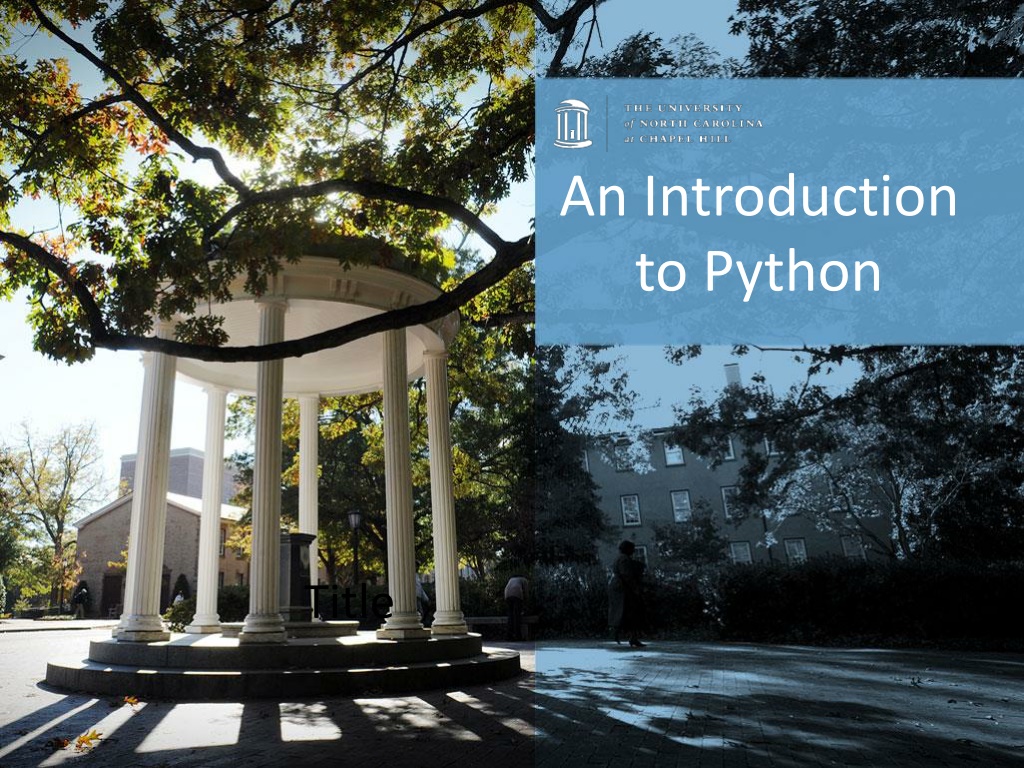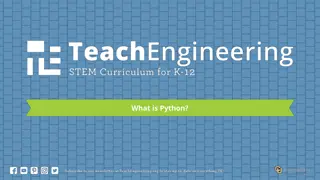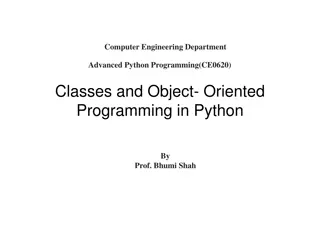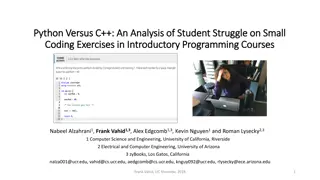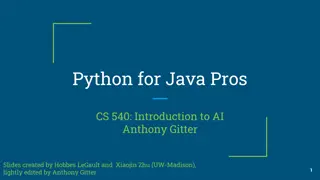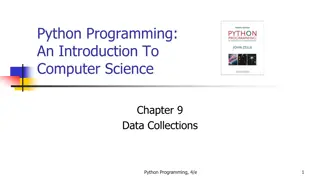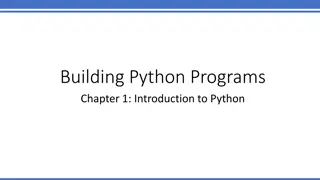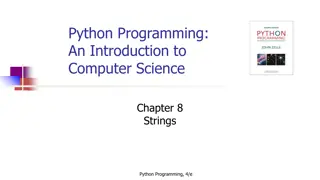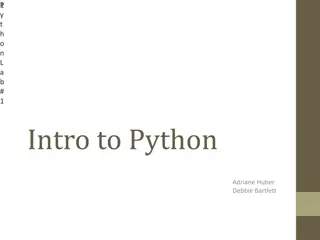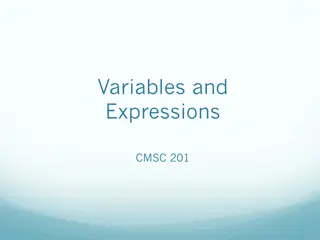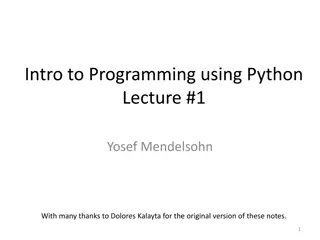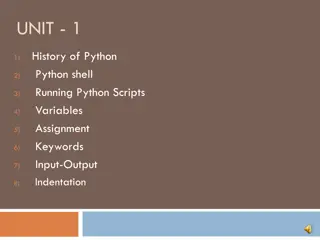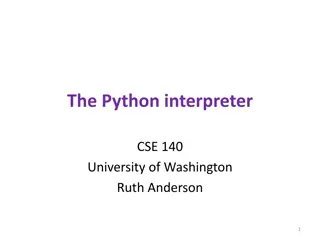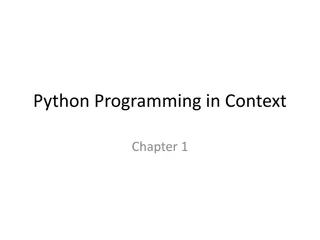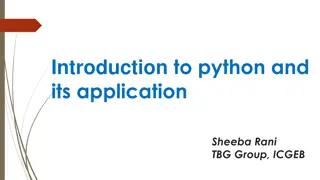An Introduction to Python
Python is a modern rapid development language known for its clean and easy-to-read code. It emphasizes a single, intuitive approach to problem-solving and allows dynamic modifications. Python is highly object-oriented, with everything treated as an object. It is suitable for small to medium projects that may grow over time, where flexibility and interfacing with different languages are important. Learn about Python data types, collections, and the basic language structure that sets it apart as a versatile programming language.
Uploaded on Mar 01, 2025 | 0 Views
Download Presentation

Please find below an Image/Link to download the presentation.
The content on the website is provided AS IS for your information and personal use only. It may not be sold, licensed, or shared on other websites without obtaining consent from the author.If you encounter any issues during the download, it is possible that the publisher has removed the file from their server.
You are allowed to download the files provided on this website for personal or commercial use, subject to the condition that they are used lawfully. All files are the property of their respective owners.
The content on the website is provided AS IS for your information and personal use only. It may not be sold, licensed, or shared on other websites without obtaining consent from the author.
E N D
Presentation Transcript
An Introduction to Python Title
What is Python exactly? Python is a modern rapid development language. Code is very clean and easy to read. Emphasizes single, intuitive approach to most problems. Everything can be modified dynamically. Highly object oriented.
When should you use Python? Small to medium projects that may grow over time. Where the ability to run anywhere is desired. Where the ability to interface with a variety of languages and systems is important. Where the amount of time the program takes to write is more important than the amount of time it takes to run.
Python is highly object oriented Everything is an object Data types Collections Functions Modules
Data types What are data types? Data types are simple objects that are coded directly into the python interpreter. Data types are the basic unit of information storage. Instances of data types are unique (in Python).
Python data types These are the most basic (and most frequently used) data types: Integer 0, 7, 13, 21, -1 Floating point 3.14, 2.718, 1.618 String 1 , 2.718 , True , None , etc Boolean True, False Null None
Collections What are collections? Collections are containers that hold other objects. Some collections will let you organize the their contents, and some are not as cooperative. Each collection type provides special features that make it useful in different circumstances.
Python collection types List an ordered, zero-indexed collection of objects, for example: [1, A , 3.0] Set an unordered collection of elements, guarantees each element is unique. For example: {1, A , 3.0} Dictionary an unordered collection of key/value pairs. Each key is unique. For example: {1: One , A :5, 3.0: Three }
Basic language structure Python abandons many of the common language formatting idioms. Newline terminates a command no semicolon required. Indentation alone designates nested code blocks no curly braces required. A # denotes the start of a single line comment.
Indentation matters Unlike most programming languages, newlines and indentation are syntax in python. Functions, nested loops and conditionally evaluated code are all indicated using indentation. Consider the following valid python code: if something is True: do_something_else()
Basic numerical operations The +, -, *, /, % (modulo) and ** (power-of) all behave roughly as expected. The = assigns the value on the right to the variable on the left. The +=, -=, *=, /= and **= perform the indicated operation between the variable on the left and the value on the right, then assign the result to the variable on the left.
Basic condition tests A == tests to see if two things have the same value. != tests to see if two things have a different value. The <, >, <=, >= all compare relative values. An is tests to see if two things have the same identity. An in tests element membership in a collection.
Boolean algebra in Python Any value, other than None, False, 0, , or an empty collection evaluates to True in a boolean context. The boolean operators supported by python, in order of increasing precedence, are: 1. and 2. or 3. not
Basic flow control Python provides flow control using if, for and while statements. You can terminate a for or while loop using break. You can skip to the next iteration of a for or while loop using continue. You can execute code after a for or while loop that is not terminated early using else.
Example: if statement if x < 0: print x is less than 0 elif x == 0: print x is 0 elif x == 1: print x is 1 else: print x is greater than 1 There can be zero or more elif conditions. The else condition is optional. The first condition that evaluates to True has its code executed, and no further conditions are examined.
Practice intermission! Time to see if you ve been paying attention. Go to http://codingbat.com/python/Warmup- 1. We ll work through sleep_in together. Please try monkey_trouble yourself. If you finish quickly, try other exercises!
Example: for statement mylist = [ cat , dog , goat ] for animal in mylist: print I have a + animal When run, this results in: I have a cat I have a dog I have a goat The for statement in python is unique in that it works over collections (or things that act like collections).
Example: break and continue statements. for number in [2, 3, 4, 5, 6, 7, 8, 9]: if number % 2 == 0: print %s is even % number elif number > 7: break else: continue print I will never be seen
Defining Functions Functions are defined in python using the def key word. The format of a function definition is def function_name(comma, separated, arguments): After a function definition, any indented lines are considered part of the function.
Default Argument Values It is also possible to define a function with default value for one or more arguments. This creates a function that can be called with fewer arguments than it is defined to allow. For example: def make_circle(size, color= white , outline=True):
Keyword Arguments Functions can be called using keyword arguments. Take the following function: def parrot(age=10, state= awake , type= African Grey ) This could be called a variety of ways: parrot(25) parrot(15, type= Norwegian Blue ) parrot(state= asleep ) Etc
Strings and Things Strings in Python are created with paired single or double quotes. Multi line strings can be created by enclosing them with three single or double quotes on each end (e.g. This could span several lines ). The + and * operators are work for strings, so help + me produces the string help me , and help * 3 produces helphelphelp .
Another practice intermission Go to http://codingbat.com/python/Warmup- 2. Try string_times using a trick you just learned for an easy warmup. Try array_count9 for a slightly larger challenge. As before, if you re quick work ahead!
String Formatting Operations String can be formatted via the % operator. If you are only substituting a single value you may pass it directly after the %. If you are passing multiple values you must wrap them in parenthesis. For example: I have %s cats % 10 I have %s cats and %s dogs % (5, 3)
Meet the List Lists are mutable, ordered collections of objects. Any type of object can be put in a list Lists may contain more than one type of object at a time. The + and * operators perform the same magic on lists that they do on strings.
Subscripts In Python, all sequences (including strings, which can be thought of as sequences of characters) can be subscripted. Subscripting is very powerful since it allows you to view a portion of a sequence with relative constraints. Python subscripts may either be single elements, or slices. For example: Help [0] is H Help [0:2] is He Help [2:4] is lp
Subscripts, continued Subscript slices can be bounded on only one end, for instance: Help [1:] is elp Help [:2] is He Subscripts can also be negative, to indicate position relative to the end of the sequence: Help [-1] is p Help [-3:-1] is el Subscript slices will return an empty result if you use indices that are out of bounds or otherwise bad. Help [5:10] is
Another practice session Head back to http://codingbat.com/python/Warmup-2. Try your hand at array_front9 using array slices and Python s nifty in feature. Use slices and the same string multiplication trick to complete front_times.
The Set A set object is an unordered collection of distinct immutable objects. Common uses include membership testing and removing duplicates from a sequence. Support x in set, len(set), and for x in set. Does not support indexing, slicing, or other sequence-like behavior.
The Dictionary A dictionary maps key objects to to arbitrary value objects. Dictionaries are accessed using square brackets like a list (slicing is not supported). For example: My_dictionary = { A :1, 0: Zero , B :2} My_dictionary[ A ] is 1 My_dictionary[0] is Zero You can set new values like so: My_dictionary[ B ] = 3 My_dictionary[1] = One Supports x in dict, len(dict) and for x in dict.
Modules As your program gets longer, you may want to split it into several files for easier maintenance. You may also want to use a handy function that you ve written in several programs without copying it into each program. Python makes this easy if your file is somewhere in the PYTHONPATH, you can do the following: import yourfile Then you can access stuff in that file like this: Yourfile.yourfunction()
